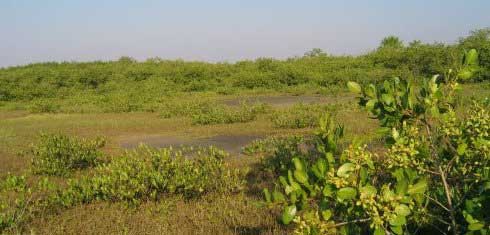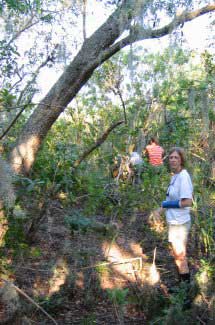 Stagnant ponds, remnants of an old tropical fish farm on Tampa Bay, will be getting a new lease on life as part of a restoration project at Newman Branch Creek in southern Hillsborough County.
Stagnant ponds, remnants of an old tropical fish farm on Tampa Bay, will be getting a new lease on life as part of a restoration project at Newman Branch Creek in southern Hillsborough County.
The project was hatched when a nonprofit group approached TECO about repairing impacted coastland the utility purchased decades ago as a buffer between its Big Bend power plant and nearby residential communities.
The 12-acre parcel straddling Newman Branch Creek was a diamond in the rough, ripe for restoration. The creek had been dredged and ditched in the 1950s for flood control. Straightening and deepening the once-meandering artery sped runoff to the bay and chased out fish that favor the hiding spaces that a gradually sloping vegetated shoreline provides. Material cast alongside one bank destroyed some of the bay’s last remaining saltern habitat – arid, salty regions that attract wading birds when inundated on high tide.
Biologists saw an opportunity to push through the berms and revive the salterns, and re-sculpt lifeless old ponds into a chain of thriving wetlands connected to the creek.
The utility agreed to make the prized parcel – just south of its Manatee Viewing Center – available for restoration, with a conservation easement to allow future public access. Agencies kicked in funding to do the work and construction is set to begin this Fall.
Projects like these are pretty rare, says wildlife biologist Dave Sumpter, director of PEER, the non-profit group that first floated the idea. Everybody kind of gets pigeon-holed. Most landowners don’t know about restoration programs and funding opportunities, he says, and mistrust regulators. Agencies are busy tackling projects on public lands. And except for mitigation required for environmental impacts, the two sides rarely connect, leaving unexplored a lot of potentially significant habitat restoration.
Restoration plans call for transforming 20 abandoned fish ponds, part of a long defunct aquaculture operation, into a graduated series of wetlands fed by Newman Branch Creek. Invasive Brazilian pepper trees will be removed to make way for native mangrove and salt marsh communities.
A small Australian pine stand south of the existing fish ponds will be replaced with low and high marsh plant communities.
On the third and largest portion of the site, biologists will punch through berms created when spoil was tossed alongside the creek bank so high tides can rehydrate historic salterns.
We had wanted to do something for a long time to restore the habitat here, says Stan Kroh, who manages the utility’s compliance and stewardship programs. When this project came up, it was such an ideal fit for us, he adds.
Newman Branch will likely open the door for other public-private partnerships. The potential is huge and it’s not yet been capitalized on, says PEER board member Tom Ries of Scheda Ecological Services.
PEER, which stands for Protecting the Environment through Ecological Research, hopes to be a catalyst. The group started as a loose collaboration of biologists eager to advance restoration and seek out projects others didn’t have the time or inclination to pursue.
In the consulting world, we react, we do mitigation for development, Sumpter says. This is about going out and doing what needs to be done, not because some regulator tells you that you have to but because there’s an opportunity.
 Salterns are increasingly rare around Tampa Bay. When inundated on a high tide, these arid, salty habitats attract wading birds that feed on the tiny fish and critters swept in.
Salterns are increasingly rare around Tampa Bay. When inundated on a high tide, these arid, salty habitats attract wading birds that feed on the tiny fish and critters swept in.
Photos courtesy Tom Ries
